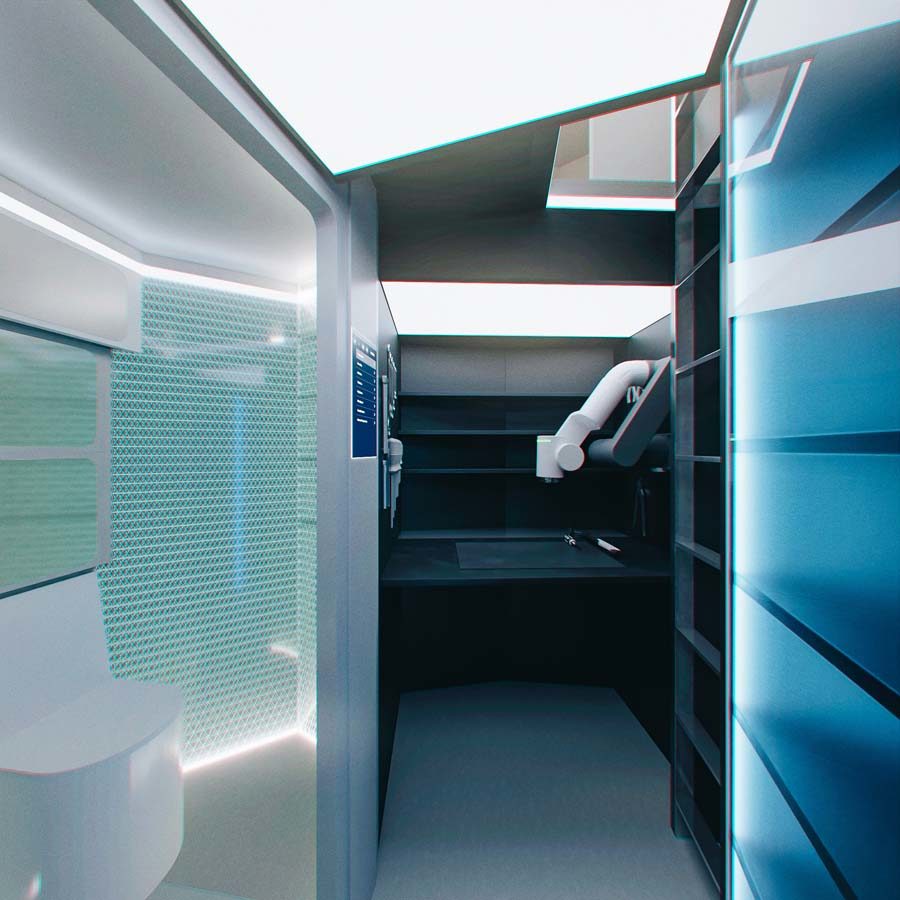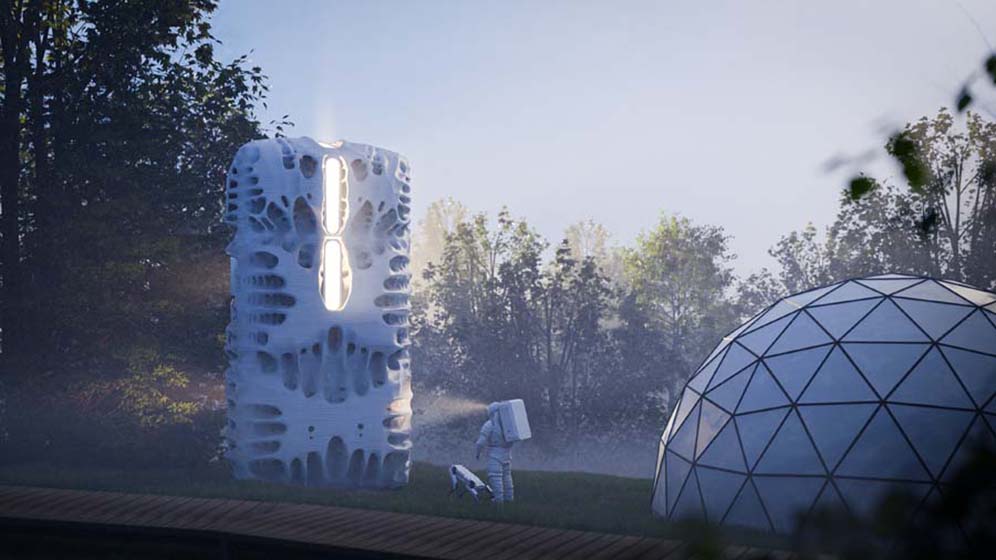Pioneering Swiss boarding school, Institut auf dem Rosenberg unveils the tallest 3D-printed polymer structure in the world as a Space Habitat, co-created by students and SAGA Space Architects
– The Space Habitat has been specifically designed to fit inside SpaceX’s Starship rocket created to carry the first inhabitants of the moon colony on the lunar surface and beyond
– The Space Habitat will house a special four-legged guest, Spot, an agile mobile robot designed by Boston Dynamics with automated walking and self-charging functions for data collection
Whilst most of the world’s leading private schools seek out earthly sites for school trips, pioneering Swiss boarding school, Institut auf dem Rosenberg looks to the stars and envisions what living and working in space might look like. Over the weekend, Rosenberg unveiled a unique 15 square-metre Space Habitat prototype co-designed by Rosenberg’s young learners and award winning SAGA Space Architects. It is the tallest 3D-printed polymer structure in the world. The Space Habitat has been specifically designed to fit inside the SpaceX’s Starship rocket created to carry the first inhabitants of the moon colony on the lunar surface, and beyond.
Bernhard Gademann, fourth-generation President of Institut auf dem Rosenberg commented: “We are incredibly proud to be bringing the study of the space environment to Rosenberg; we do not want to regard this as futuristic, but an imperative subject for the next generation to understand now. Without exposure to these contemporary and significant subject areas, our pupils cannot imagine or ideate the very different world they will encounter beyond the school gates when they graduate in years to come. We are infusing education with real life context at the heart of everything we do here, rather than only focusing on pure text book academics. I very much hope we can become an incubator to the most advanced concepts here at Rosenberg, giving space to the most avant-garde ideas, which is a phenomenal opportunity for our pupils to learn and rub shoulders with the world’s top innovators.”
Together, SAGA Space Architects and the students of Rosenberg, aged six to eighteen, successfully executed the co-creation of the Space Habitat. The habitat found its form through incredible, innovative, bio-mimicry observations and computed algorithms following the students’ initial creative concepts, designs, and paper models for space life settlement.
 Pioneering the space architecture industry, SAGA, co-founded by Karl-Johan Sørensen and Sebastian Aristotelis and based in Copenhagen is a multi-planetary architectural and technology design agency, which is building life-sustaining architecture for Earth and Space. SAGA’s design approach to outer space is human-centric and draws inspiration from nature with a focus on wellbeing to create visionary and sensitive buildings that are perfectly fit for Earth or space life.
Pioneering the space architecture industry, SAGA, co-founded by Karl-Johan Sørensen and Sebastian Aristotelis and based in Copenhagen is a multi-planetary architectural and technology design agency, which is building life-sustaining architecture for Earth and Space. SAGA’s design approach to outer space is human-centric and draws inspiration from nature with a focus on wellbeing to create visionary and sensitive buildings that are perfectly fit for Earth or space life.
The space-optimised structure consists of three floors for a crew of two. Floor One is dedicated to hygiene, lab research and workshop facilities. Floor Two is designed for work, recreation and entertainment, whilst Floor Three is intended for privacy and rest. With mental wellbeing and sustainability at the forefront of SAGA’s designs, the floors and furniture of the habitat is multi-functional, allowing for as many various activities as possible within the limited space. With two sleeping pods on the top floor, the shape gives the primary living quarters a higher ceiling, which helps make the space feel larger.
Embedded in the learning of the Space Habitat, Rosenberg students will engage in immersive learning modules that activate creative problem solving by utilising arts, science, and technology, allowing for interconnected learning between disciplines rather than siloed subjects – therefore not a simulation but an kinetic-immersive learning in a real-life context Research and development experiments will include questions of human well-being, using facilities for plug-and-play to test hard and software tools, and applications, plus co-creating monitoring tools for remote mission control systems. Learners will also explore the importance of sensory stimulation in remote living environments with light, sound and smelling installations. Valuable experiential learning projects will help their skills in systems-thinking by working with automated mechatronics 1 and observing independent communication and deeper learning of artificial intelligence. SAGA Space Architects predicts extra-terrestrial settlements will rapidly become a reality within the next decade – meaning students will be well ahead of the curb in their understanding of this next phase of human development.
The Space Habitat will also be a vehicle for data collection and analysis. The facility will house a four-legged guest, Spot, an agile mobile robot designed by Boston Dynamics with a self-charging unit and as a basis for automated walks intended for data-collection. It will also create opportunities for students to use robots from other partners such as ABB for 3-D or future multifunctional co-bots. 2
 Robots, Vertical Farms, Wind Trees & Climate Gardens Rosenberg is no stranger to future casting, having already established a Future Park, which houses the Space Habitat and is a showcase of Rosenberg’s mission to revolutionise education and to close the gap between education and the real, professional world of the 21st century. In this state-of-the-art facility, students can undertake projects guided by expert partners in the fields of science and technology, including leading university for science and technology ETH Zurich and machine learning experts, ABB and Boston Dynamics who have collaborated with the school which hosts their robots. Students can use the contemporary educational space of the Future Park to anticipate and shape the future of humanity on earth and beyond, from growing their own produce for the kitchen using revolutionary vertical farms, through to harnessing the power of man-made wind trees to create electricity for the school’s personalised Audis.
Robots, Vertical Farms, Wind Trees & Climate Gardens Rosenberg is no stranger to future casting, having already established a Future Park, which houses the Space Habitat and is a showcase of Rosenberg’s mission to revolutionise education and to close the gap between education and the real, professional world of the 21st century. In this state-of-the-art facility, students can undertake projects guided by expert partners in the fields of science and technology, including leading university for science and technology ETH Zurich and machine learning experts, ABB and Boston Dynamics who have collaborated with the school which hosts their robots. Students can use the contemporary educational space of the Future Park to anticipate and shape the future of humanity on earth and beyond, from growing their own produce for the kitchen using revolutionary vertical farms, through to harnessing the power of man-made wind trees to create electricity for the school’s personalised Audis.
1 an interdisciplinary branch of engineering that focuses on the integration of mechanical, electronic and electrical engineering systems
2 is a robot intended for direct human robot interaction within a shared space, or where humans and robots are in close proximity
 About Institut auf dem Rosenberg:
About Institut auf dem Rosenberg:
At Institut auf dem Rosenberg they are proud to offer a uniquely contemporary learning experience, enabling exceptional academic results and personal development well beyond traditional education. Their outstanding team of teachers and professionals are more than just educators: they are true Artisans of Education. Rosenberg is a Swiss boarding school providing a state-of-the-art, holistic learning environment for responsible leaders of the 21st century. They are passionate about the development of meaningful learning experiences for children and young adults, typically aged 6 to 18 years. Founded in 1889, their Swiss boarding school environment is renowned for its individual approach to education, enabling outstanding academic performance while featuring an unmatched array of Talent & Enrichment courses, all designed to broaden young minds and nurture their creativity. In a rapidly changing the world, the need for education to evolve is of more importance than ever before. While no one can predict the future, in a world increasingly driven by advances in technology, Institut auf dem Rosenberg must inherently nurture human skills such as creativity, intuition and interpersonal social skills.
For more information, please contact Helena Hembrow at Mercury Communications:
helena@mercurycomms.com
www.mercurycomms.com
rosenberg@mercurycomms.com
+44 (0) 7765 348 224
 SAGA Space Habitat – Gerhardus Breedt
SAGA Space Habitat – Gerhardus Breedt
What work and experiments will the students be doing?
Students will engage in immersive learning modules that activate creative problem solving by utilizing arts, science and technology. Research and development experiments will include questions of human well-being, using facilities for plug-and-play to test hard- and software tools and applications and co-creating monitoring tools for remote mission control systems. Learners will also explore the importance of sensory stimulation in remote living environments with light, sound and smelling simulations. Valuable experiential learning projects will help their skills in systems-thinking by working with automated mechatronics and observing independent communication and deeper learning of artificial intelligence. This research facility is also a vehicle for data collection and analysis.
How big will the space habitat be and what is the extent of the features within the habitat?
The Space Habitat is 15 m2 divided on three floors: Floor 1 is dedicated to hygiene, lab, research and workshop facilities. Floor 2 is designed for recreation and entertainment. Floor 3 is intended for privacy and rest.
Is this the first of its kind / biggest of its kind?
Yes it is a unique prototype and the tallest 3D-printed polymer structure in the world.
How will students be leading the study; how will students be steering the direction of the curriculum and study?
How do we create the right questions that will help us design the solutions for the anticipated future of human existence on earth and beyond? Developing good research questions and understanding how to steer through disruptive occurrences without knowing the outcome will be embedded in the learning within the Space Habitat.
 How does the Rosenberg space habitat compare to the space environments being created within the industry by SAGA, NASA or UK Space?
How does the Rosenberg space habitat compare to the space environments being created within the industry by SAGA, NASA or UK Space?
The Space habitat is specifically designed to fit inside the Starship rocket developed by Space-X to bring first inhabitants of the moon colony in the mid 2020ies.
Why is the study of the space environment important for lives today and the future? What is the relevance of the study of the space environment?
This is twofold: Innovation and Technology benefits humans in problem solving of terrestrial challenges linked to sustainability. Secondly, it is our DNA to explore from the equator to interstellar existence.
How will Rosenberg involve the wider community or partners connected to Rosenberg as a result of the Space Habitat?
The Space Habitat will house SPOT of Boston Dynamics for self-charging and as a basis for automated walks intended for data-collection. It will also create opportunities for students to use Robots from other partners such as ABB for 3-D or future delivery co-bots.
How many Rosenberg students will be involved in the space habitat, what age groups will be studying the subject?
This is a community project of all students aged 6 to 18 who co-created the space habitat and found its form through bio-mimicry observations and computed algorithms following their initial designs in drawings and paper models.
What subjects / courses does the study of the space habitat fall into?
The unique appeal of the Space Habitat for subject teachers is that it allows for interconnected learning demonstrating the magic that links arts, sciences, humanities and languages.






